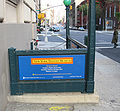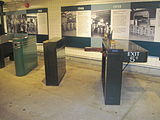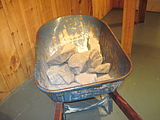- New York Transit Museum
-
New York Transit Museum Established 1976 Location Court Street (IND Fulton Street Line) Type Railway and mass transit museum Public transit access Bus: B25, B26, B38, B41, B45, B52, B57, B61, B62, B103
Subway:
Court Street – Borough Hall





Jay Street – MetroTech




Website http://www.mta.info/mta/museum/
The New York Transit Museum is a museum which displays historical artifacts of the New York City Subway, bus, commuter rail, and bridge and tunnel systems; it is located in a decommissioned Court Street subway station in the Brooklyn Heights neighborhood of New York City. There is a smaller satellite annex in Grand Central Terminal, Manhattan.Contents
The Museum
On July 4, 1976, the New York City Transit Exhibit opened in the decommissioned station as part of the United States Bicentennial celebration, with one subway token for admittance. Old cars which had been preserved, as well as models and other exhibits were displayed. Plans were to close it after the celebration, but it proved to be so popular that it remained open and eventually became a permanent museum.
The Transit Museum main entrance is located at the corner of Boerum Place and Schermerhorn Street. Also, there is a new, separate ADA-accessible entrance for those with physical disabilities.[1] The Museum includes subway, bus, railway, bridge, and tunnel memorabilia and other exhibits including vintage signage, models and dioramas of subway, bus and other equipment, and lectures and seminars. Tours and programs are available at the Museum for all ages. The Museum also offers offsite programs which consist of guided tours of MTA facilities, subway stations, artwork and architecture, and New York neighborhoods, as well as opportunities to ride vintage railway and bus equipment.
The museum's mezzanine (upper) level contains the majority of the exhibits, restrooms, water fountains, a screening room, and even a dining space for visitors who have brought their own food or drink. Artifacts from historic subway and bus operations, as well as NYC transportation, are on display. The exhibits on the upper level frequently change.
On the platform (lower) level, two working subway tracks contain many historic examples of New York City Subway and Elevated railway equipment as a permanent display. Preserved subway cars date as far back as the predecessor companies that came before the New York City Transit Authority, such as the BMT and IRT private companies and the city owned and operated IND. In addition to the subway cars, there is a large motor truck display, a working signal tower exhibit, and several other artifacts that highlight subway signaling, station signage, and station artwork.
Most of the subway cars in the Transit Museum's fleet are operable, and museum cars are frequently used for subway excursions run by the Museum and New York City Transit on various parts of the system. Tickets for Transit Museum excursions (called "Nostalgia Trains") are sold in advance. New York City Transit excursions (such as Holiday specials at the end of most years, and Yankee/Met specials) are available for anyone to ride, so long as they've paid the regular subway fare. Since mid 2005 the March of Dimes excursions were suspended.
In addition to the subway cars stored in the Transit Museum, there are also some Museum cars that are kept in various subway yards and shops that are either awaiting restoration, undergoing restoration, or not currently being displayed.
Besides subway cars, the Museum has a sizable vintage bus fleet. However, there is no area set aside for their permanent exhibition at the Museum, and therefore they are stored in various Bus depots around the city. They are brought out for special events, such as the Museum's annual "Bus Festival," which is held annually in conjunction with the Atlantic Antic street fair. The Bus Festival began as an annual tradition in 1994. During the Bus Festival, the Museum opens its doors for free.
The Museum also maintains a sizable archive. Documents, photographs, and artifacts are stored both in the Museum and in the nearby Archives, adding to the goal of preserving the legacy of transportation in New York. Historians and researchers who wish to visit the Archives are able to do so through the Museum. Some images from their collection can also be seen on Historypin.[2]
The station
Court Street New York City Subway rapid transit station 
Station platform with museum exhibitsStation statistics Address Schermerhorn Street & Boerum Place
Brooklyn, NY 11201Borough Brooklyn Locale Downtown Brooklyn Coordinates 40°41′25″N 73°59′24″W / 40.6904°N 73.99°WCoordinates: 40°41′25″N 73°59′24″W / 40.6904°N 73.99°W Line IND Fulton Street Line Services None (currently occupied by museum) Structure Underground Platforms 1 island platform Tracks 2 Other information Opened April 9, 1936 Closed June 1, 1946 Accessible  (station was not accessible when it was in service)
(station was not accessible when it was in service)Station succession Next north (Terminal) Next south Hoyt–Schermerhorn Streets Court Street station was built as a terminus for local trains of the IND Fulton Street Line and opened on April 9, 1936, along with a long section of the Fulton Street Line and the Rutgers Street Tunnel. The station has one center island platform with two tracks. The tracks end at bumper blocks just beyond the west end of the platform.
The station demonstrated the IND service theory that specified that local trains should operate within individual boroughs where possible and provide transfers to express trains, which would be through-routed between the boroughs. Court Street was to be the northern terminal of the HH Fulton Street Local, which would run south to Euclid Avenue. Additionally, one of the plans for the Second Avenue Subway would have included a southern extension to Brooklyn, tying into the stub at Court Street to accommodate through service from Manhattan.
The HH through service was never inaugurated; the only trains to the station were part of the Court Street Shuttle, taking passengers from Court Street to the transfer station at Hoyt–Schermerhorn Streets. Due to the proximity of other stations in the Downtown Brooklyn area, as well as the need to transfer to reach it, Court Street never saw much service and was abandoned on June 1, 1946. However, it is still a functioning subway station; trains are moved into and out of the exhibits using the line between here and Hoyt–Schermerhorn station's outer two tracks.
Around 1960, the station began to be used as a set for movies, most notably the 1974 film The Taking of Pelham One Two Three, and the entrance at Boerum Place and Schermerhorn Street was reopened for shoots. To this day, the station and its connecting tunnels are still used for movie shoots. The 2009 The Taking of Pelham One Two Three, a remake of the 1974 movie, was also filmed there. More recently, the museum appeared in the Life on Mars episode "The Simple Secret of the Note In Us All", where a newspaper columnist is found murdered on a subway car. The Museum remains open to requests to use the station for filming, as well as to host private events during hours the Museum is not normally open.
Museum expansion
Grand Central Gallery Annex and Store
Grand Central Terminal Gallery Annex & Store
The New York Transit Museum Gallery Annex and Store opened on September 14, 1993 at Grand Central Terminal, in the terminal's main concourse. It houses a gift shop as well as a space for exhibitions.[3] Exhibits frequently change in the Annex. Most notably, the Annex is the site of the Transit Museum's annual "Holiday Train Show," where an operating model train layout is displayed for the public. While there is a small admissions fee at the Transit Museum's Brooklyn Heights location, entrance to the annex is free.
The main Brooklyn heights location also has a gift shop, which is accessible outside of the museum's paid area.
Scope Expansion
In the mid-1990s the Metropolitan Transportation Authority (MTA) assumed control of the Transit Museum from the New York City Transit Authority. In doing so, the scope of the museum was expanded to include other aspects of transportation services within the MTA, including commuter rail (Metro-North, Staten Island Railway, Long Island Rail Road) and roads/bridges (MTA Bridges and Tunnels). Since this time, rotating exhibits on the mezzanine level frequently highlight commuter railroad and bridge/tunnel operations, as well as their history.Current exhibits
Currently, the Museum features several exhibits:
- Steel Stone and Backbone, which highlights the challenges and labor involved in subway construction during the period 1900-1925.
- Fare Collection, which explains different methods New Yorkers have used to pay subway fare over the years, and contains authentic subway turnstiles for passage through
- The Triborough Bridge: Robert Moses and the Automobile Age, which discusses the construction of the Triborough Bridge, recently renamed the Robert F. Kennedy Bridge
- Show Me the Money: From the Turnstile to the Bank, which explains the old (pre-2006) process of revenue collection in the New York City Subway
- Inspiring Spaces: 25 Years of MTA Arts for Transit, which displays public art samples from subway and commuter rail stations
- On the Streets, which contains a comprehensive history of New York City's street transportation from horse pulled vehicles to modern buses, as well as two bus installations visitors can sit in, including the driver's seat
- Clearing the Air, which discusses modern street transportation and its impact on the environment, and highlights steps that the MTA is taking to reduce its carbon footprint.
- Stop Look and Listen, which allows visitors to enter a working subway signal tower dating from 1936 and see how trains are kept a safe distance apart and supervised
- Moving the Millions, which chronicles the history of the subway system from the private operators to the MTA New York City Transit of today. Located on the platform level, it is designed to supplement a visitor's experience exploring the various subway cars on display in the museum.
Cars on display
(display order as of 5/5/2011)
Track A1:
- R1 100
- R4 484
- R7A 1575
- BMT D-Type Triplex 6095A-B-C
- BRT AB Standard 2204
- R11 8013
- R16 6387
- R30 8506
Track A2:
- BRT BU Gated El Cars 1404, 1273, 1407
- BMT Q-Type El Car 1612C
- IRT R33 World's Fair 9306
- IRT R15 6239
- IRT R12 5760
- R95 Revenue Collection Cars OR714 and IR714 (former IRT R21 7194 and IRT R22 7422)
- IRT Lo-V 4902
- Long Island Railroad Caboose C-60
- SBK Steeplecab 5
- Diesel Locomotive 10
Turnstiles
Various turnstiles from the history of subways are on display at the NYC Transit Museum. They date as far back as the subway's opening in 1904, and as close to the present as turnstiles that were still in use as recently as 2003. The exhibit is designed to be interactive and viewed in conjunction with a large board that details the history of fare payment in the subway. Most of the turnstiles can be walked through by visitors wishing to do so. Also viewable in conjunction with this exhibit are several token vending machines that were used to sell subway tokens prior to the advent of the Metrocard.
Transit Museum Cars not on permanent display
- R10 3189
- IRT R17 6609 (stored on tracks south of the Museum due to lack of platform space)
- R32 3352-3353 (Rebuilt as Phase II)
- R36 9542-9543
- R38 4028-4029
- R40 4280-4281
- R40A 4480-4481
- R42 4572-4573
Gallery
A Diamond Jubilee subway token on displayOld subway turnstilesSample rocks excavated during subway constructionAd from inside train on displayMachine used to sew bags of subway tokensSee also
References
- ^ "Transit Museum Becomes Accessible To Disabled". NY1. June 8, 2011. http://www.ny1.com/content/news_beats/transit/140642/transit-museum-becomes-accessible-to-disabled. Retrieved 2011-06-25.
- ^ New York Transit Museum on Historypin
- ^ "New Yorkers & Co.". The New York Times. September 19, 1993. http://www.nytimes.com/1993/09/19/nyregion/new-yorkers-co-688293.html. Retrieved 2009-09-22.
External links
Categories:- Defunct New York City Subway stations
- IND Fulton Street Line stations
- Museums in Brooklyn
- Museums in Manhattan
- Railroad museums in New York
Wikimedia Foundation. 2010.








